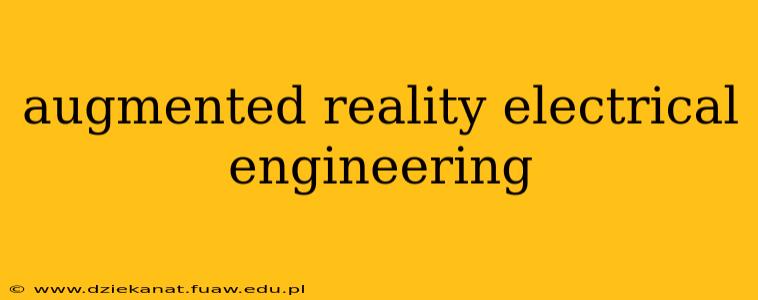Augmented reality (AR) is rapidly transforming numerous industries, and electrical engineering is no exception. By overlaying computer-generated images onto the real world, AR offers a powerful toolkit for enhancing design, streamlining training, and improving maintenance procedures. This technology is poised to revolutionize how electrical engineers work, learn, and troubleshoot complex systems.
What is Augmented Reality and How Does it Apply to Electrical Engineering?
Augmented reality uses devices like smartphones, tablets, and specialized headsets to project digital information onto a user's view of the real world. In electrical engineering, this translates to visualizing complex electrical schematics overlaid on physical equipment, interactive 3D models of circuits, and real-time data analysis displayed directly on machinery. This hands-free approach offers significant advantages over traditional methods.
How Can AR Improve Electrical Engineering Design?
Improved Collaboration and Visualization: AR allows engineers to collaborate on designs remotely, viewing and manipulating 3D models in real-time, regardless of geographical location. This fosters faster iteration and reduces design errors.
Enhanced Prototyping and Testing: Before physical prototyping, AR allows for virtual testing and adjustments, saving time and resources. Engineers can visualize and interact with virtual prototypes, identifying potential issues before committing to manufacturing.
Simplified Complex Designs: AR can simplify the comprehension of intricate circuit boards and electrical systems by providing interactive 3D models and annotated schematics. This makes understanding and modifying complex designs significantly easier.
How is AR Revolutionizing Electrical Engineering Training?
Immersive Learning Experiences: AR provides an immersive and interactive learning environment, replacing traditional textbook learning with engaging simulations and virtual labs. Trainees can safely practice complex procedures in a risk-free virtual environment.
Improved Knowledge Retention: The interactive nature of AR enhances knowledge retention. By actively engaging with virtual components and simulations, trainees learn more effectively and remember the information longer.
Reduced Training Costs: AR-based training reduces the costs associated with physical equipment, specialized instructors, and potential damage during training. This makes training more accessible and cost-effective.
How Can AR Improve Electrical Engineering Maintenance?
Simplified Troubleshooting: AR can overlay schematics and diagnostic data directly onto equipment, guiding technicians through troubleshooting procedures step-by-step. This significantly reduces downtime and improves efficiency.
Remote Expert Assistance: AR facilitates remote expert assistance. A technician on-site can share their AR view with a remote expert, who can then guide them through repairs or maintenance procedures in real-time.
Improved Safety: AR can highlight potential hazards and provide safety instructions directly to technicians, reducing the risk of accidents and injuries during maintenance work.
What are the benefits of using AR in electrical engineering?
The benefits of using AR in electrical engineering are numerous and span the entire workflow, from initial design to maintenance and repair. These include improved collaboration, faster design cycles, enhanced training, reduced errors, and increased safety. Ultimately, AR improves efficiency, reduces costs, and leads to higher quality outcomes.
What are the challenges of implementing AR in electrical engineering?
Despite its potential, implementing AR in electrical engineering faces some challenges. The high initial cost of AR hardware and software can be a barrier for some companies. Developing high-quality AR applications requires specialized skills and expertise, and ensuring compatibility across different devices and platforms can be complex. Finally, widespread adoption requires addressing potential concerns about data security and privacy.
What are some examples of AR applications in electrical engineering?
Several companies are already using AR in electrical engineering. Examples include using AR headsets to visualize wiring diagrams overlaid on real equipment during maintenance, interactive 3D models of circuit boards for design review, and AR-based training modules for new technicians. The applications are diverse and constantly evolving.
What is the future of AR in electrical engineering?
The future of AR in electrical engineering is bright. As AR technology continues to improve and become more affordable, its adoption in the field is expected to accelerate. We can anticipate more sophisticated AR applications, integration with other technologies like AI and IoT, and wider accessibility for engineers and technicians at all levels. AR is poised to become an indispensable tool for electrical engineers in the years to come.

